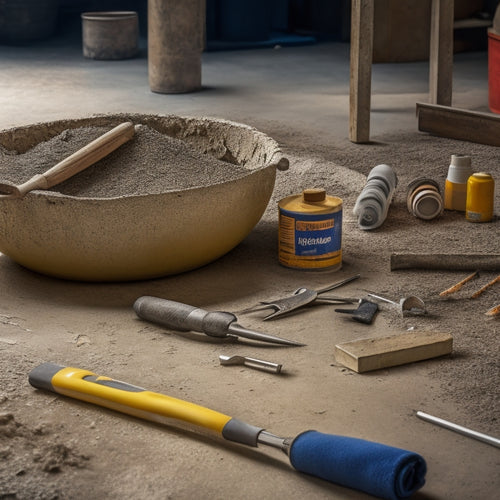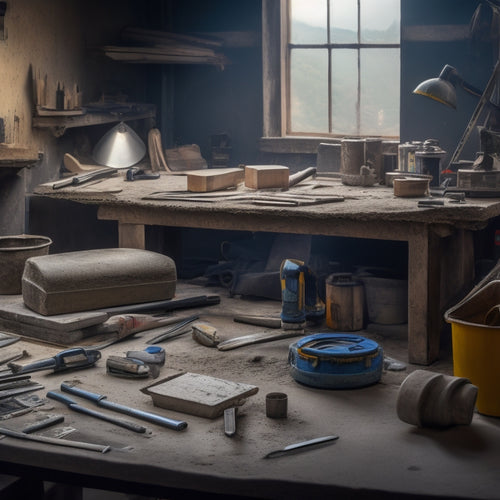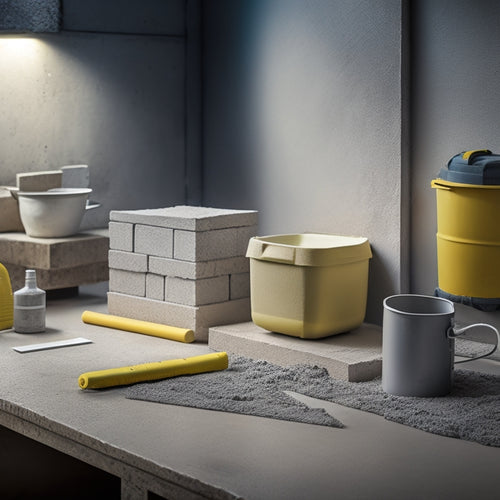
Why Choose These Hand Tools for Concrete Blocks
Share
You're about to commence on a concrete block project that requires precision, strength, and durability, and the right hand tools are essential to achieving a professional-looking finish. By choosing the right tools for mixing, tamping, leveling, raking, and finishing, you'll guarantee a strong bond between blocks and a durable structure. From mixing buckets and drill paddles to spirit levels and tamping tools, each hand tool plays a critical role in the construction process. With the right tools and techniques, you'll be able to achieve a smooth, even finish and a structurally sound building - and by continuing, you'll discover the specifics that will take your project to the next level.
Key Takeaways
• Ensures structural integrity and durability by facilitating proper tamping, leveling, and alignment of concrete blocks.
• Enhances efficiency and productivity with specialized tools for mixing, raking, and finishing concrete.
• Provides precise control and accuracy for achieving professional-looking results and smooth finishes.
• Offers a comprehensive range of tools for every stage of concrete block construction and finishing.
• Supports safety and prevents accidents by following safety guidelines and using durable, high-quality tools.
Essential Tools for Mixing Concrete
You'll need a set of essential tools to efficiently mix concrete for your concrete block project, including a mixing bucket, mixing stick, and a drill with a mixing paddle attachment. A sturdy mixing bucket with a capacity of at least 5 gallons is ideal for mixing small to medium-sized batches of concrete.
When selecting a mixing stick, choose one made of durable materials, such as fiberglass or steel, to withstand the rigors of mixing. A drill with a mixing paddle attachment will make quick work of mixing, saving you time and effort.
In addition to these primary tools, having a few secondary tools on hand can be helpful. A concrete shovel, for example, is useful for scooping and pouring concrete into the mixing bucket.
You may also want to take into account having a trowel or scoop for measuring and adding ingredients to the mix. By having the right tools, you'll be able to mix concrete efficiently and safely, ensuring a successful outcome for your concrete block project.
Tamping Tools for Block Laying
After preparing the concrete mixture, the next vital step in building with concrete blocks is to lay them accurately. This requires a set of specialized tamping tools to guarantee a solid bond between the blocks and the foundation.
You'll need to verify the blocks are properly aligned and seated to prevent shifting or settling over time. Tamping tools, such as hand tampers or plate compactors, are designed to apply the necessary pressure to compact the blocks and eliminate air pockets.
Mastering tamping techniques is essential to achieving a strong and stable structure. By using the right tamping tools and following proper techniques, you can verify a solid bond between the blocks and the foundation, which is vital for load-bearing walls and structures.
The tamping benefits are numerous, including increased structural integrity, improved durability, and reduced risk of cracking or shifting. By investing in high-quality tamping tools, you can verify a professional finish and a safe, long-lasting structure.
Remember to always follow safety guidelines when working with tamping tools to avoid accidents and injuries.
Hand Trowels for Smooth Finishing
As you prepare to apply the finishing touches to your concrete block project, you'll need to focus on achieving a smooth, even surface.
To do this, you'll need to master the art of using a hand trowel, paying close attention to the angle at which you hold it.
Trowel Angle Matters
Maintaining a precise trowel angle is essential for achieving a smooth, even finish when laying concrete blocks, ensuring a professional-looking result. When you hold your trowel at the correct angle, you'll be able to spread and level the mortar evenly, reducing the risk of unevenness and imperfections.
The ideal angle varies depending on the type of trowel you're using and the specific task at hand. For instance, a pointed trowel is best held at a steeper angle for scooping and spreading mortar, while a square-edged trowel is better suited for finishing and smoothing.
Regular trowel maintenance is also important for achieving the desired angle. Make sure to clean and inspect your trowel regularly to prevent buildup and damage. A well-maintained trowel will allow you to maintain a consistent angle, resulting in a higher-quality finish.
Additionally, consider investing in multiple trowel types to suit different tasks and angles, such as a finishing trowel for smooth finishing and a pointing trowel for filling gaps.
Smooth Finishing Techniques
Smooth Finishing Techniques
To achieve a smooth, even finish, you'll need to employ precise hand trowel techniques, carefully manipulating the tool to create a uniform surface. This requires a combination of proper trowel angle, movement, and pressure. As you work, focus on maintaining a consistent pace and applying gentle to moderate pressure, depending on the concrete's moisture level.
Here are some key smoothing techniques to master:
| Technique | Description | Benefit |
|---|---|---|
| Floating | Use a trowel to spread and smooth the concrete, applying gentle pressure. | Removes excess water, creates a uniform surface |
| Screeding | Hold the trowel at a 45-degree angle, using a sawing motion to remove excess concrete. | Evens out the surface, removes imperfections |
| Finishing | Use a trowel to apply finishing touches, creating a smooth, even finish. | Enhances appearance, prepares for further finishing |
| Edging | Use a trowel to smooth and shape edges, creating a clean finish. | Prevents cracks, enhances overall appearance |
| Final Float | Use a trowel to apply a final, smooth finish, removing any remaining imperfections. | Achieves a high-quality, professional finish |
Edging Tools for Clean Lines
When working with concrete blocks, you'll need edging tools to create clean lines and precise joints, guaranteeing a professional-looking finish. These tools are essential for achieving accurate edging techniques, which are vital in maintaining the structural integrity of your concrete block construction. A well-maintained edging tool is important in preventing accidents and guaranteeing a safe working environment.
Here are some essential edging tools you should consider:
-
Jointer: A jointer is used to create a smooth, even surface between concrete blocks. It helps to remove excess mortar and creates a clean joint.
-
Edger: An edger is used to create a clean, straight edge on concrete blocks. It's ideal for creating precise joints and corners.
-
Trowel edger: A trowel edger is used to apply and smooth out mortar between concrete blocks. It's perfect for creating a clean, even surface.
- Pointing trowel: A pointing trowel is used to fill in gaps and joints between concrete blocks. It's ideal for creating a professional-looking finish.
Remember to always follow proper tool maintenance procedures to guarantee your edging tools are in good condition. This will help you achieve accurate edging techniques and prevent accidents on the job site.
Leveling Tools for Accurate Placement
When you're working with concrete blocks, you'll need to guarantee accurate placement to achieve a sturdy structure.
To do this, you'll rely on leveling tools that help you achieve precise block alignment, guaranteeing level surfaces, and checking plumb lines.
Precise Block Alignment
You'll need to guarantee precise block alignment by using leveling tools that help you accurately place each concrete block in its designated position. This guarantees that your structure is stable, secure, and meets building codes.
In order to achieve precise block alignment, you'll need to employ effective block alignment techniques and utilize alignment measurement tools.
Here are some essential leveling tools to take into account:
-
Spirit levels: These tools indicate whether a surface is perfectly horizontal or vertical, allowing you to make precise adjustments.
-
Laser levels: These devices project a level line or dot, enabling you to check the alignment of multiple blocks at once.
-
Tamping tools: These tools help you compact and level the soil or sand beneath the blocks, ensuring a solid foundation.
- Block alignment gauges: These gauges provide a quick and easy way to check the alignment of adjacent blocks, ensuring a straight and level course.
Ensuring Level Surfaces
To guarantee accurate placement of concrete blocks, you must first create a level surface, which involves using specialized tools to verify and adjust the elevation of the foundation or substrate. This critical step in surface preparation guarantees that your concrete blocks are laid evenly, preventing structural issues and safety hazards.
| Leveling Tool | Description | Purpose |
|---|---|---|
| Spirit Level | Measures surface inclination | Verifies surface levelness |
| Laser Level | Projects level lines | Guarantees accurate placement |
| Tamping Tool | Compacts aggregate materials | Prepares substrate for blocks |
When choosing a leveling tool, consider the size and complexity of your project. Spirit levels are ideal for small to medium-sized projects, while laser levels are better suited for larger, more intricate constructions. Additionally, don't forget to use a tamping tool to compact aggregate materials and create a stable substrate for your concrete blocks. By mastering these leveling techniques, you'll guarantee a solid foundation for your concrete block construction, guaranteeing safety and structural integrity.
Checking Plumb Lines
After guaranteeing a level surface, you're ready to verify plumb lines, which involves checking the vertical alignment of your concrete blocks to prevent deviations that can compromise the structural integrity of your construction.
This vital step guarantees that your walls are straight and your blocks are properly aligned, which is essential for a safe and durable structure.
To check plumb lines, you'll need the right tools. Here are some essential hand tools to take into account:
-
Plumb bob: A plumb bob is a weighted string that helps you determine if your blocks are perfectly vertical. It's a simple yet effective tool that's been used for centuries.
-
Laser level: A laser level projects a level line or dot onto your wall, allowing you to check the alignment of your blocks with precision. This tool is especially useful for larger construction projects.
-
Spirit level: A spirit level is a handheld tool that indicates when your blocks are perfectly level or plumb. It's a must-have for any concrete block project.
- String and stakes: A string and stakes can be used to create a reference line for your blocks, guaranteeing that they're properly aligned and spaced.
Raking Tools for Even Distribution
Raking tools are designed to facilitate even distribution of concrete within the block mold, guaranteeing uniform density and preventing air pockets from forming.
When you use the right raking tool, you can achieve a smooth, consistent finish. To get the best results, you'll need to master various raking techniques. For instance, you can use a gentle sweeping motion to spread the concrete evenly, or a more aggressive back-and-forth motion to remove excess material.
The material selection of your raking tool is also essential. Look for tools made from durable materials like stainless steel or heavy-duty plastic, which can withstand the rigors of concrete work. A high-quality raking tool will help you achieve a professional finish, while a low-quality tool can lead to uneven distribution and air pockets.
By choosing the right raking tool and mastering the right techniques, you can guarantee a strong, durable concrete block that meets your project's requirements.
Pointing Trowels for Filling Gaps
You'll need a pointing trowel to precisely fill gaps and voids in the concrete block, guaranteeing a solid, uniform structure. This tool is essential for gap filling, allowing you to achieve a smooth, even surface.
When choosing a pointing trowel, consider the following key features:
-
Blade material: Stainless steel or high-carbon steel blades are ideal for durability and rust resistance.
-
Blade shape: A curved or angled blade enables smooth, precise application of mortar or concrete.
-
Handle material: A comfortable, ergonomic handle made of durable materials like fiberglass or wood guarantees a secure grip.
- Size: Select a trowel that fits comfortably in your hand, with a blade size suitable for the specific gap-filling task.
Jointing Tools for Strong Bonds
To create strong bonds between concrete blocks, you need jointing tools that can effectively pack and finish joints, guaranteeing a stable and durable structure. When selecting jointing tools, consider those designed for peak bond strength. A jointing trowel, for instance, helps to compress and finish joints, promoting a strong bond between blocks.
Additionally, a jointing iron is crucial for packing and finishing joints, especially in areas where a high-strength bond is critical.
When using jointing tools, it's important to employ proper jointing techniques to achieve maximum bond strength. This includes using the correct amount of pressure, maintaining a consistent joint width, and finishing joints in a way that prevents water from entering the joint.
By following these guidelines and using the right jointing tools, you can guarantee a strong and durable bond between concrete blocks. This, in turn, will result in a structurally sound and safe building that can withstand various environmental conditions.
Frequently Asked Questions
Can I Use a Shovel to Mix Concrete Instead of a Mixing Bucket?
When mixing concrete, you're tempted to use a shovel, but it's not the best option.
Square-edged shovel types can scrape and damage the mixing surface, while rounded-edged ones may not effectively combine the mixture.
Furthermore, the concrete consistency can become uneven, leading to weak spots.
Instead, opt for a mixing bucket specifically designed for concrete, ensuring a smooth, consistent blend that's safer and more reliable.
Do I Need to Clean My Tools After Each Use?
You'll be digging your own grave if you don't clean your tools after each use!
Seriously, tool maintenance is essential to extend their lifespan and prevent rust. You should develop a habit of cleaning your tools using gentle techniques, such as wiping them with a soft cloth or brushing off debris.
Regular cleaning will also help prevent the buildup of concrete residue, ensuring your tools remain in top condition for your next project.
Are There Any Safety Precautions When Working With Concrete?
When working with concrete, you must take safety precautions seriously.
You're exposed to concrete dust, a hazardous material that can cause respiratory issues and skin irritation. Always wear protective gear, including a dust mask, safety goggles, and gloves, to minimize exposure.
Make sure you're working in a well-ventilated area, and avoid eating or drinking near the work site.
Can I Use a Single Tool for Both Mixing and Laying Concrete?
As you dip your hands into the concrete mix, imagine the perfect blend of art and science.
Can you use a single tool for both mixing and laying concrete? The answer is yes, but with caution.
A trowel or shovel can suffice for small batches, but be mindful of mixing techniques and laying methods to avoid compromising the concrete's integrity.
Confirm you're using the right tool for the job to prevent contamination and achieve a smooth finish.
How Often Should I Replace My Hand Tools for Optimal Performance?
You'll want to replace your hand tools regularly to maintain peak performance and guarantee your safety on the job.
The tool lifespan varies depending on usage and maintenance. As a general rule, inspect your tools daily and replace them every 3-6 months or sooner if you notice signs of wear, such as rust, corrosion, or damage.
Proper performance maintenance is key to preventing accidents and making sure you get the job done efficiently.
Conclusion
Congratulations, you've made it to the end of this exhaustive list of hand tools for concrete blocks!
You're probably exhausted from all the excitement, but don't worry, it's almost over.
Now that you've got the essentials, you can finally stop using your bare hands to mix concrete (gross) and start building something that won't crumble under its own weight.
With these tools, you'll be well on your way to creating a structure that's almost as sturdy as your resolve to finish this project. Almost.
Related Posts
-

Top Tools for Repairing Cracked Concrete Surfaces
When tackling a cracked concrete surface repair, you'll need the right tools to guarantee a durable fix. Start with e...
-

3 Best Hand Tools for DIY Concrete Construction
When tackling a DIY concrete construction project, you'll need three essential hand tools to achieve a professional-l...
-

What Tools Do I Need for Concrete Block Laying
You'll need a thorough set of tools to guarantee accurate, efficient, and professional concrete block laying. Essenti...


